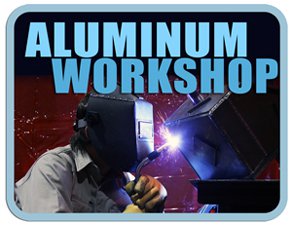FYI only
Aluminum Workshop: The burning question behind welding aluminum with FCAW/SAW
Practical Welding Today November/December 2013
November 11, 2014
By:
Frank Armao
 Q: I heard recently that there is a flux-cored wire available for aluminum GMAW. Is this true? If so, can you tell me who makes it? Also, why isn’t flux-cored wire more commonly available for aluminum GMAW?
Q: I heard recently that there is a flux-cored wire available for aluminum GMAW. Is this true? If so, can you tell me who makes it? Also, why isn’t flux-cored wire more commonly available for aluminum GMAW?
A: First of all, as far as I know, there is no flux-cored wire available for aluminum GMAW. This is a rumor that seems to make the rounds every few years. AWS has no filler specification for aluminum flux-cored GMAW wires.
I will say that theoretically it is possible to develop flux-cored wires for aluminum. They were even demonstrated in the laboratory many years ago. So have fluxes for submerged arc welding (SAW) aluminum, which do not exist commercially either.
So what’s the problem? If it’s possible to weld aluminum with FCAW and SAW, why isn’t it done? The problem lies in turning a laboratory process into a production process. In order for a flux to be effective, it must be more chemically active than the material—in this case, aluminum—it is trying to protect.
If you recall, aluminum is very high on the electromotive force chart, so most elements and compounds are not effective fluxes for it. The chemicals used in fluxes for carbon steels or stainless steels don’t work for aluminum. The fluxes that have been developed for aluminum have several highly undesirable properties. First, they are very corrosive, so that every bit of them must be removed from each weld pass before proceeding. Second, they are extremely hygroscopic (they absorb water from the air). This means that extremely rigid storage conditions are necessary. If you do not follow these procedures, you will get a weld with a tremendous amount of porosity. Last, the chemicals composing these fluxes are very nasty from an environmental standpoint.
So, in a nutshell, that’s why the FCAW and SAW processes have never been commercialized for aluminum. Do these reasons seem similar to the reasons that SMAW is no longer used in most places for aluminum? They should, because they are fundamentally the same.
Frank Armao
Contributing Writer
The Lincoln Electric Company
22801 St. Clair Ave.
Cleveland, OH 44117
Phone: 216-481-8100
Fax: 216-486-1751
You can absolutely gmaw aluminum with a simple cv dc power source with ar/ar-he shielding gas including small 110v mig machines. This is why the small migs such as a Millermatic 141 are set up for the low end spool guns. A spool gun or a push-pull gun is necessary to feed correctly. There are aluminum feeding kits available to feed thru standard guns but aluminum doesn't have the column strength to be pushed that far correctly. In short those kits suck. I'm not aware of any quality fcaw aluminum wire.


